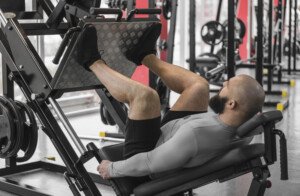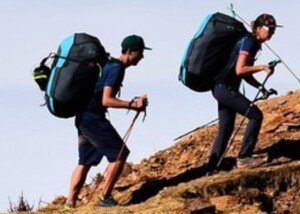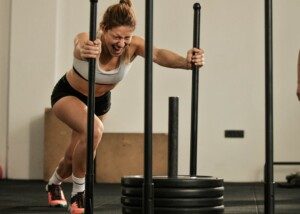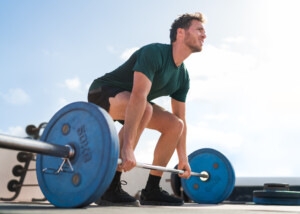Can people whose femurs are shorter than their shins, regardless of torso length, have a mechanical advantage with the leg press?
Nearly all the attention regarding the long femur problem is directed at the back squat.
However, when it comes to the leg press equipment, having short shins and elongated femurs – regardless of overall body height — needs to be considered.
Certainly you’ve seen men on the leg press equipment, doing full-range-motion reps with a ton of weight.
And their quads were bulging with muscle. I’ve seen this many times, but I’ve also noticed something else that comes with this — 100% of the time:
And that’s what appears to be a femur length that’s SHORTER than the shin length.
I have never, ever seen a man (or woman, for that matter) with short shins and long femurs WHO ALSO had thighs bulging with muscle.
This makes me believe that whatever disadvantages long femurs and short shins cause in the back squat, are also present with the leg press.
The only difference between the two exercises is that the biomechanical disadvantage isn’t felt the way it is when performing the back squat.
Overall Body Height
It’s a common belief that a very tall person automatically is at a disadvantage with the leg press equipment due to having to crumple or stuff their legs under the sled and having a longer range of motion through which to push the sled up.
Though the sled’s range of motion is the same (obviously) due to the equipment’s track, a tall person — with their longer legs — must seemingly bend their legs a lot more than a very short person needs to, to move that sled all the way down and all the way back up.
They certainly need to push through a greater range of motion at the beginning if they have super long legs.
But once they get going, the alleged greater range of motion is cancelled out by those longer legs.
Imagine a Baby Under the Sled
The distance the sled travels will be less than if an adult were to use the machine.
But the baby’s short legs would still need to bend all the way down (knees to chest) and all the way back out to a soft lockout of the knees, in order to do what would be a complete range of motion.
Never mind that the sled makes it only one-third up the track at the top of the baby’s pressing motion due to the little legs.
After all, for the baby (or adult with very short legs), it’s still a full range of motion for their legs:
• Knees to chest or armpits to lower the weight
• Legs straightening to raise the weight
• Legs straight (soft knee lock) at the top of the movement
What about people with femurs longer than shins?
Imagine you’re watching someone on the leg press equipment from the side. Imagine they have femurs five times their shin length.
Though these are unrealistic proportions, they will help you understand the disadvantage.
So keep picturing these proportions as the person brings their knees to their chest to lower the weight.
Now animate them for reps. Up and down, up and down. What do you see? You should see a huge range of motion for their thighs.
Look at their hip, where the pivoting action occurs. Look at the distance between that and their knees. Up and down, up and down.
That’s a lot of space through which to move the weight.
Now flip the proportions: Visualize very short femurs, and shins five times the length.
Animate him for reps. Watch the hip (pivotal area) and note the distance between there and the knees as he performs reps.
That’s a very short range of motion for the femurs!
This is why a person with shins LONGER than their femurs will be able to, in general, press a lot more weight with their legs, and more efficiently.
This explains why it seems that whenever a man is leg pressing a ton of weight with full range of motion, he has “stubby” but muscular bulging thighs — and longer lower legs.
Imagine this Fascinating Experiment
• Imagine yourself sliding into the leg press machine.
• Imagine that your knees magically move half a foot up your thighs, giving you a longer shin to shorter thigh ratio. Nothing else changes. Your body height stays the same.
• You are “all calves” and “no femur.”
• Unlock the safety latch and begin lowering the sled.
• Gee, you have it lowered all the way (knees to chest) almost instantly, because your knees were already very close to your chest in the start position!
• Now push back up. You only had to push back up a short distance to straighten your legs!
• Now imagine your knees are close to your ankles. You’re “all thighs” and “no calves.”
• Start lowering the weight.
• Gee, it takes a lot longer for your knees to reach your chest. The joint travels a longer distance – and that’s why it’s much harder work for the same amount of weight!
If you’re cursed with being all thighs and short shins, all you can do with the leg press is to keep training hard.
And follow these guidelines:

Freepik/master1305
• Keep feet flat on the sled; do not let heels disconnect.
• Do not do hard lockouts at the top of the movement.
• Incorporate very deep sets (which will require lighter weight) by letting your knees splay to either side of your chest when lowering.
• In other words, do not make all your sets knees to chest, as the chest gets in the way of ROM no matter what your proportions are. Splay the knees for some sets!
• Do partial reps. Bring the sled down deep (splay the knees), then push up only three-quarters of the way, then come back down.
 Lorra Garrick is a former personal trainer certified through the American Council on Exercise. At Bally Total Fitness she trained women and men of all ages for fat loss, muscle building, fitness and improved health.
Lorra Garrick is a former personal trainer certified through the American Council on Exercise. At Bally Total Fitness she trained women and men of all ages for fat loss, muscle building, fitness and improved health.
.



























